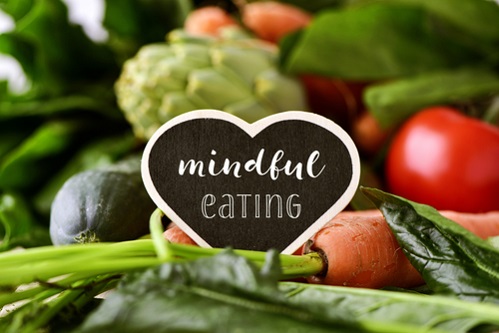Mindful Eating Meditation for Emotional Eating: Practices and Insights

Are you struggling with emotional eating? Do you find yourself turning to food when you’re stressed, sad, or overwhelmed?
In this article, we will explore the power of mindful eating meditation to help you break free from the cycle of emotional eating. By practicing simple techniques and gaining insights into your emotional triggers, you can develop healthier eating habits and find a deeper connection between your emotions and food.
Get ready to cultivate self-compassion and make lasting changes in your relationship with food.
Key Takeaways
- Mindful eating develops awareness of thoughts, emotions, and physical sensations related to food.
- Tuning into hunger and fullness cues helps eat when truly hungry and stop when satisfied.
- Identifying trigger foods helps avoid or find healthier alternatives.
- Coping with emotional triggers involves finding constructive ways to manage stress and regulate emotions.
The Role of Mindfulness in Emotional Eating
Mindfulness plays a crucial role in helping you overcome emotional eating habits. By practicing mindful eating, you can develop a deeper awareness of your thoughts, emotions, and physical sensations related to food. This heightened awareness allows you to make conscious choices about what and how much you eat, rather than being driven by impulsive or emotional urges.
Mindfulness helps you tune into your body’s hunger and fullness cues, enabling you to eat when you’re truly hungry and stop when you’re satisfied. It also helps you become more attuned to the sensory experience of eating, such as the taste, texture, and smell of food. By being fully present in the moment during meals, you can savor each bite and derive greater satisfaction from your food.
Mindfulness empowers you to break free from the cycle of emotional eating and cultivate a healthier relationship with food.
Understanding Emotional Triggers for Overeating
In this discussion, you will explore the key points of identifying trigger foods, understanding the difference between emotional and physical hunger, and learning effective ways to cope with emotional triggers.
By understanding which foods trigger your overeating, you can take steps to avoid them or find healthier alternatives.
Differentiating between emotional and physical hunger will help you make better choices when it comes to nourishing your body.
Lastly, discovering healthy coping mechanisms for emotional triggers will enable you to break free from the cycle of emotional eating.
Identifying Trigger Foods
When trying to identify trigger foods, it’s important to pay attention to how certain foods make you feel emotionally. Emotional eating triggers can vary from person to person, so it’s crucial to be mindful of your own unique experiences.
Take note of how specific foods affect your mood, energy levels, and overall well-being. Do certain foods make you feel comforted or uplifted? Or do they leave you feeling guilty or anxious? By observing these emotional responses, you can start to recognize patterns and identify the trigger foods that may be contributing to your emotional eating habits.
Once you’ve identified these trigger foods, you can then take steps towards overcoming emotional eating. This might involve finding healthier alternatives or implementing strategies to cope with emotional triggers in a more constructive way.
Emotional Versus Physical Hunger
Feeling physical hunger is characterized by a rumbling stomach and a sensation of emptiness. It’s your body’s way of telling you that it needs nourishment. On the other hand, emotional hunger cues are often driven by our emotions rather than our body’s need for fuel. It can be harder to recognize emotional hunger because it doesn’t have the same physical signals as physical hunger does. To help you differentiate between the two, here are some key differences:
| Physical Hunger Signals | Emotional Hunger Cues |
|---|---|
| Stomach rumbling | Sudden cravings |
| Feeling empty | Specific food cravings |
| Weakness or lightheadedness | Desire to eat without feeling physically hungry |
| Difficulty concentrating | Eating to distract from emotions |
| Improved mood after eating | Guilt or shame after eating |
Coping With Emotional Triggers
To cope with emotional triggers, you can try identifying healthier ways to manage stress and find activities that bring you joy or relaxation. Emotional triggers can be overwhelming, but there are strategies you can use to regulate your emotions and navigate through difficult situations.
Here are three coping strategies that can help:
- Deep Breathing: Taking slow, deep breaths can activate your body’s relaxation response and help calm your mind. Focus on your breath, inhaling deeply through your nose and exhaling slowly through your mouth.
- Mindfulness Meditation: Practicing mindfulness can help you become aware of your emotions without judgment. Take a few minutes each day to sit quietly and observe your thoughts and feelings as they arise, allowing them to come and go without getting caught up in them.
- Engaging in Creative Activities: Engaging in activities such as painting, writing, or playing music can provide a healthy outlet for your emotions. These activities can help you express and process your feelings in a constructive way.
Techniques for Developing Mindful Eating Habits
Try incorporating practices like slowing down your eating pace and savoring each bite to develop mindful eating habits.
When it comes to emotional eating triggers, it’s important to be aware of your emotions and how they can influence your relationship with food.
Mindful eating techniques can help you become more attuned to your body’s signals and make conscious choices about what and how much you eat.
By slowing down and savoring each bite, you can fully experience the flavors and textures of your food, which can enhance your satisfaction and reduce the need for emotional eating.
Pay attention to your hunger and fullness cues, and try to eat when you are physically hungry rather than in response to emotions.
Developing these mindful eating habits can support your overall well-being and help you establish a healthier relationship with food.
Exploring the Connection Between Emotions and Food
Now that you’ve learned some techniques for developing mindful eating habits, let’s delve into the connection between emotions and food.
It’s no secret that our emotions can heavily influence our eating habits. When we’re feeling stressed, sad, or even bored, we often turn to food for comfort. However, this emotional eating can have various effects on our overall well-being.
Here are three emotional eating patterns and their potential consequences:
- Stress eating: When stress takes over, we may find solace in high-calorie, unhealthy foods. This can lead to weight gain and feelings of guilt and dissatisfaction.
- Binge eating: Emotionally-driven binge eating can result in a loss of control and overconsumption of food. This can lead to weight gain, digestive issues, and a negative body image.
- Restrictive eating: On the other hand, some individuals may suppress their emotions by restricting their food intake. This can lead to nutrient deficiencies, low energy levels, and an unhealthy relationship with food.
Understanding these emotional eating patterns is crucial in developing a healthy relationship with food and finding alternative ways to cope with our emotions.
Mindful Eating Exercises for Managing Emotional Cravings
When you’re struggling with emotional cravings, it can be helpful to focus on your breath and engage in deep belly breathing. Mindful eating techniques are a powerful tool for managing these cravings and gaining control over your eating habits.
By being present in the moment and fully aware of your thoughts and emotions, you can better understand the root causes of your cravings. Take a deep breath in, feeling the air fill your lungs, and then exhale slowly, releasing any tension or stress.
As you eat, pay attention to the colors, textures, and flavors of your food. Chew slowly and savor each bite, allowing yourself to fully experience the sensations.
Cultivating Self-Compassion in the Face of Emotional Eating
Cultivating self-compassion in the face of emotional eating can help foster a more nurturing and understanding relationship with ourselves. When we struggle with emotional eating, it’s easy to beat ourselves up and feel guilty. But by practicing self-acceptance and self-kindness, we can break free from this cycle of negativity.
Here are three ways to cultivate self-compassion:
- Offer yourself grace: Instead of berating yourself for giving in to emotional eating, remind yourself that you are human and it’s okay to have challenges.
- Practice self-care: Engage in activities that nourish your mind, body, and soul. Take time for yourself and prioritize self-care practices that bring you joy and contentment.
- Challenge negative self-talk: Replace negative self-talk with positive affirmations. Remind yourself that you are worthy of love and kindness, regardless of your struggles.
Integrating Mindfulness and Emotional Intelligence for Lasting Change
In this discussion, you will explore the key points of emotional intelligence benefits, mindfulness, and sustainable change.
You will discover how emotional intelligence can enhance your relationships and overall well-being by improving your ability to understand and manage emotions.
Emotional Intelligence Benefits
Emotional intelligence benefits can be experienced through regular practice of mindful eating meditation. By cultivating self-compassion and being present in the moment, you can enhance your emotional well-being and develop a healthier relationship with food.
Here are three ways in which mindful eating meditation can benefit your emotional intelligence:
- Increased self-awareness: By paying attention to your thoughts, feelings, and bodily sensations while eating, you can become more aware of your emotional triggers and patterns of behavior related to food. This self-awareness allows you to make conscious choices and respond to emotions in a more balanced way.
- Improved self-regulation: Mindful eating meditation helps you develop the ability to pause and reflect before acting upon your emotions. This practice allows you to respond to emotional cues with wisdom and choose nourishing foods that support your well-being, rather than succumbing to impulsive or emotional eating.
- Enhanced empathy and connection: As you cultivate self-compassion through mindful eating meditation, you also develop a greater sense of empathy and compassion towards others. This increased empathy fosters deeper connections and understanding in your relationships, leading to greater emotional intelligence and overall well-being.
Mindfulness and Sustainable Change?
Now that you understand the benefits of emotional intelligence, let’s delve into the power of mindfulness practices for long-term change.
Mindfulness is more than just a passing trend; it is a transformative tool that can help you make sustainable changes in your life. By practicing mindfulness, you become more aware of your thoughts, emotions, and behaviors, allowing you to make conscious choices instead of acting on autopilot.
Mindful eating meditation, in particular, can help you break free from emotional eating patterns by bringing awareness to your triggers and providing a space for self-reflection.
Frequently Asked Questions
Can Mindful Eating Meditation Completely Eliminate Emotional Eating?
Yes, mindful eating meditation can help you reduce emotional eating. By practicing techniques like paying attention to your food and eating slowly, you can gain control over your emotions and make healthier choices.
How Long Does It Take to Develop Mindful Eating Habits?
Developing mindful eating habits takes time and practice. It varies for each person, but consistently practicing mindful eating can lead to benefits like reducing emotional eating and increasing awareness of hunger and fullness.
Are There Any Specific Foods That Should Be Avoided During the Mindful Eating Process?
During mindful eating, it’s important to be aware of the specific foods that may hinder your progress. Avoiding trigger foods and unhealthy snacks can help you overcome challenges and maintain emotional balance while practicing mindful eating.
Can Mindfulness and Emotional Intelligence Be Used to Address Other Types of Addictions?
Yes, mindfulness and emotional intelligence can be used to address other types of addictions. Mindfulness and emotional intelligence can be powerful tools in addiction recovery, including overcoming substance abuse.
Is Mindful Eating Meditation Suitable for Everyone, Regardless of Their Emotional Eating Triggers?
Mindful eating meditation can be a personalized approach for everyone, regardless of emotional eating triggers. It helps you develop emotional intelligence and manage stress through mindful eating practices.







